Contents
Growing a persimmon from a seed at home is quite difficult, although possible. To do this, the seeds are prepared in the refrigerator, germinated in a damp cloth and planted in the ground at the end of March. When growing, it is important to create good lighting, while the temperature can be at room temperature. If all the rules are followed, fruiting will begin no earlier than six years later.
What do persimmon seeds look like?
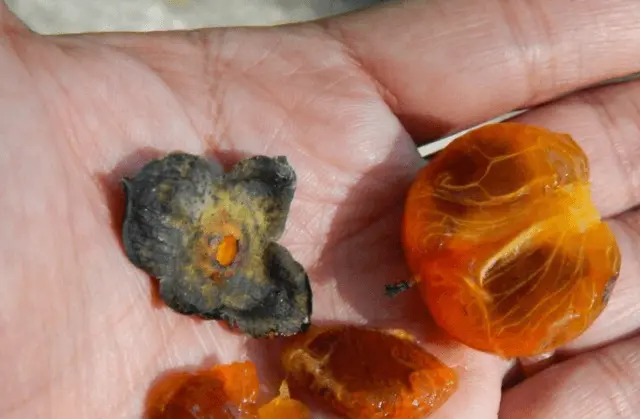
Persimmon seeds are oblong in shape and brown in color of varying intensity (from light to dark)
The seeds are medium in size: 6–8 mm long, 2–3 mm wide. The shell is hard, not damaged during storage and transportation.
Is it possible to grow a persimmon from a seed
Persimmon can be grown from a seed even at home. But there are a few important things to keep in mind:
- You need to choose the right variety. If it is self-fertile, then the fruits will appear without pollination. Otherwise, it will be possible to grow persimmon from a stone only through vaccination.
- Seeds are stratified in the refrigerator for 2-3 months.
- Plants need good lighting (backlight required) and moisture.
- It will be necessary to constantly regulate the temperature for the period of active growth, fruiting and wintering.
- During the first five years, the seedling is transplanted every year into a new, larger pot.
Persimmon fruits, which were grown from seeds at home, are usually smaller in size. However, in taste and aroma, they are in no way inferior to specimens grown in traditional ways. If there is enough sunlight, watering and top dressing, then homemade persimmon turns out to be even tastier.
Choosing a persimmon variety for growing at home
In the apartment you can grow different varieties of persimmons. The following varieties are suitable for this purpose: Gaili, Fuyu, Zenji Maru, Hyakume, Jiro, Hachiya.
How to plant a persimmon seed at home
You can grow persimmons from seeds at home. For this, the bones are carefully prepared, the soil is selected. Pots are placed on the brightest window and monitor temperature, humidity and other conditions.
Selection and germination of persimmon seeds
Bones can be ordered from trusted suppliers or removed independently from the fetus. Moreover, the fruits must be ripe, without external damage. If they are green, you can hold them for 3-5 days at room temperature or next to the battery for ripening. At the same time, the fruits should not be frozen – they can only be taken during the harvest period (September and October). If the persimmon is covered with mold, dark spots, such seed should also be discarded.
Seeds are pre-checked for germination and treated. To do this, prepare a pinkish (no more than 1%) solution of potassium permanganate and lower all the grains into them. Withstand 2 days. If any grains float, they are removed.
Next, the seeds must be immersed in a growth stimulator solution. To do this, you can take “Epin”, “Kornevin”, “Zircon”.
Instead, it is permissible to use freshly squeezed aloe juice, diluted with water 2 times.
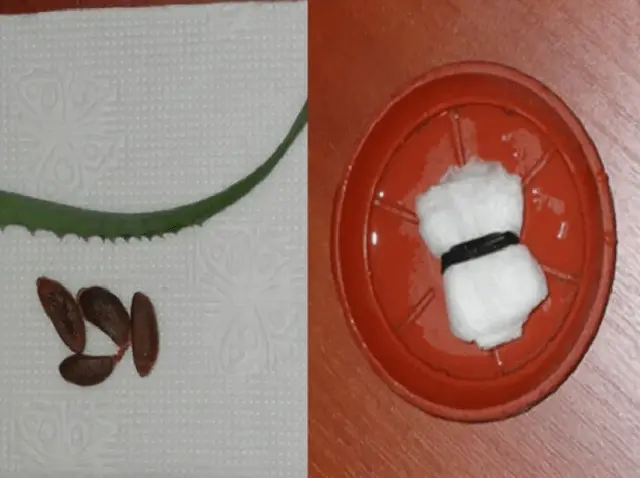
After keeping in a solution that stimulates growth, the seed material is wrapped in a damp cloth and sent to the refrigerator (on the shelf with vegetables) for 3 months.
The fabric is periodically moistened with water. The napkin must be constantly kept moist. It is recommended to put a cloth with seeds in a plastic container with a lid, then you can practically not add water.
Landing is planned for the spring. The best time is from the end of March to the beginning of April. It’s not worth it before, because it will not be possible to germinate persimmon seeds with a lack of sunlight. 5 days before planting, a wet wipe is kept next to the radiator for a week (but not on the radiator itself). In this case, you need to look for mold on the bones. If a problem is found, then the damaged grains should be discarded, since it will not work to grow persimmons from such seed.
By the time of planting, the sprouts from the persimmon seed should already hatch. If this does not happen, it is recommended to file the side hard edges with sandpaper. This will help speed up the germination process.
To do this, file the sides of the grains with sandpaper and immerse them for a day in warm water with a growth stimulator solution. Then they are planted in fertile soil and grown under a film.
Soil preparation and drainage
At home, it is possible to germinate a persimmon seed only in fertile and light soil. It is necessary to purchase a universal soil for seedlings or make it yourself on the basis of the surface layer of the earth, humus or compost, sand and peat in a ratio of 2: 1: 1: 1. Pebbles, expanded clay and other small stones are used as drainage. They are placed at the bottom of the container.
Rules of landing
To get a tree with fruits, you need to plant persimmon seeds according to the following instructions:
- Carefully loosen and moisten the substrate from the sprayer (water should be settled, at room temperature).
- Deepen the bones by 2-2,5 cm with the edge down (put on the side) at a distance of 5 cm from each other.
- Sprinkle with loose soil, without tamping it.
- Cover with a film or plastic bag, making a few holes in it.
- Put in a warm place (on a lighted window).
If all requirements are met, persimmon sprouts from the stone (pictured) will appear in 6-8 weeks.
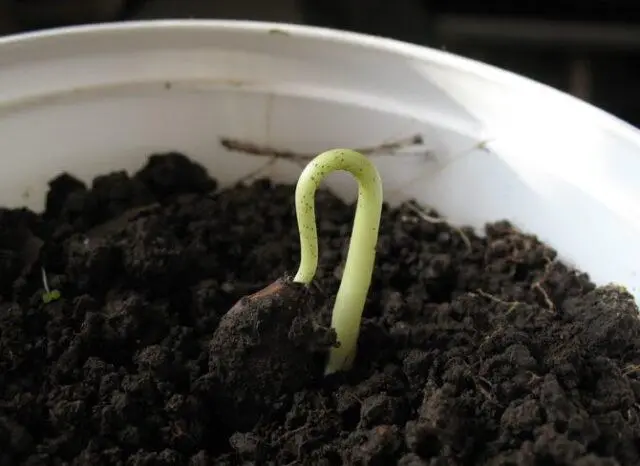
Shoots make their way to the surface for quite a long time, this period can last up to two months after planting
How to care for persimmon shoots
When growing persimmons from the stone at home, you need to ensure proper tree care. The culture needs additional lighting, regular watering and fertilization. Plants will need periodic transplantation, as well as pruning and crown shaping.
Lighting
Persimmon is demanding for good lighting. To grow trees with delicious fruits, pots are placed on the windowsill of the brightest window. Choose a south or southeast direction. However, even this measure will not be enough in early spring. Therefore, it is necessary to organize the backlight with a phytolamp for 2 hours in the morning and in the evening. The device is placed at a height of 30-50 cm from the top of the seedling.
But the summer sun can burn the leaves, so in the hot period they need to be shaded with thick paper.
Temperature conditions
Persimmon, growing from a seed in a pot, requires the maintenance of heat in the house. It is necessary to create a temperature in the range of 22–23 degrees Celsius. This can be done in any room, so it is not necessary to create special conditions. A stronger seedling that has been grown can withstand even lower temperatures – plus 15-17 ° C.
To grow a hardened tree, in the spring the pots are periodically taken out to the loggia for ventilation, and in the summer they are left there for the whole season. At the end of autumn, the containers are transferred to a cool room with a temperature of no more than 10 degrees Celsius. Some varieties have good winter hardiness, so they can withstand drops to -10 ° C.
You should not be afraid of this, because under natural conditions, persimmon gives fruit in September and October, when it gets cooler outside.
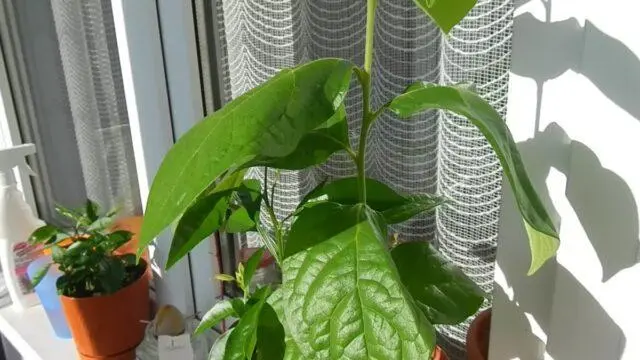
In summer, pots with seedlings can be kept outside
Watering and humidity
The soil is watered with warm, settled water from a spray bottle. This should be done regularly, avoiding drying out. Moisture stagnation is also undesirable. It is enough to spray 2-3 times a week. The first 1,5 months the film is kept closed. But it needs to be cleaned 3 times a week for ventilation.
As soon as sprouts appear, the film is still held, but opened for a long time. Then they are closed again, after which they are gradually removed. When two sheets appear, it can be removed completely.
The grown seedlings are watered regularly, at least twice a week. Then watering is reduced to 2-3 procedures per month. It is necessary to ensure that the soil does not dry out. But stagnant moisture is unacceptable. Due to the accumulation of water, the roots may die.
Therefore, in the heat, seedlings are sprayed several times a day. Nearby put an open container with water.
fertilizers
It is possible to grow trees with edible fruits with the obligatory application of top dressing. Fertilizers are added at least 3 times per season:
- In April they give urea or ammonium nitrate. Use the minimum amount of substance so as not to cause excessive growth of green mass.
- During fruit setting (from the age of 6), superphosphate is added.
- After harvesting the fruits – potassium sulfate or potassium salt.
Transfer
During the first five years of life, seedlings are recommended to be replanted annually, as they grow very quickly. For the procedure, choose a wider and higher pot (4-5 cm) than the previous one. Expanded clay is poured to the bottom.
The seedling is placed so that the roots take up 2/3 of the volume. After 5 years, persimmons are transplanted once every 2-3 years. In order to grow a healthy tree, it is transferred to a new pot by transshipment with the preservation of an earthy coma. The procedure is scheduled for the end of March.
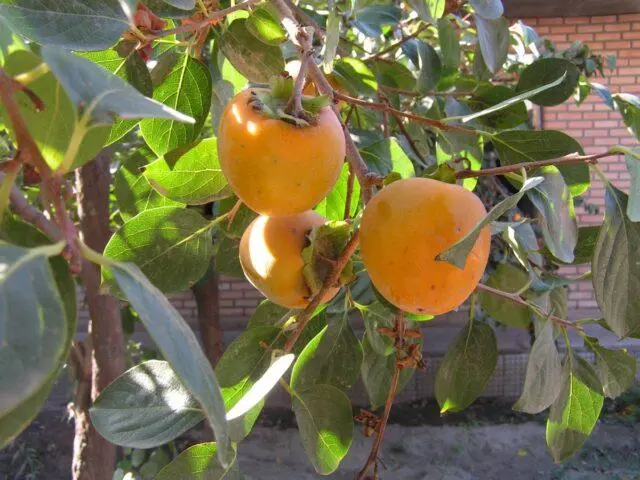
Young plants are transplanted annually, choosing a container of the appropriate volume.
Pruning and shaping the crown
If it was possible to grow a persimmon from a seed, and the seedling reached a height of 30–50 cm, then they begin to form a crown. To do this, pinch the top and let the side shoots grow. When they reach a length of 30-40 cm, they are also pinched.
In the future, the crown is formed in the form of a ball. It is necessary to make sure that all branches grow relatively evenly. Then the crown is only periodically thinned out, removing shoots growing inward. This is quite enough to grow a healthy and attractive tree.
Does persimmon bear fruit from the seed
Propagation of persimmons with a bone can be done at home. To do this, you must consistently maintain optimal conditions in the room. If all the rules are followed, then fruiting will begin from the seventh year of life. However, the tree can be grafted – then the first crop will appear in the third or fourth year.
It should be noted that fruits are not formed in all cases:
- If the variety is self-fertile, then the flowers do not need pollinators. This means that the persimmon will form on its own.
- If the variety needs pollinators, it will be necessary to vaccinate, otherwise there will be no fruiting. And although persimmon can be grown from a seed, it will remain only an ornamental tree.
Conclusion
Growing a persimmon from a seed at home is real, but the process is quite laborious. Indoors, you need to periodically change the temperature, simulating a warm season, autumn or winter. You will need to maintain a high level of humidity in the air, conduct moderate watering. If the variety is not self-fertile, it is necessary to vaccinate.









